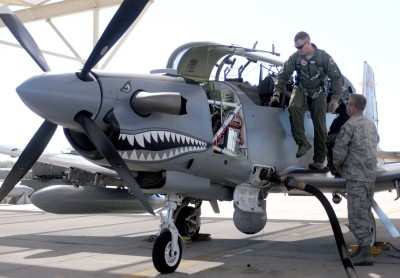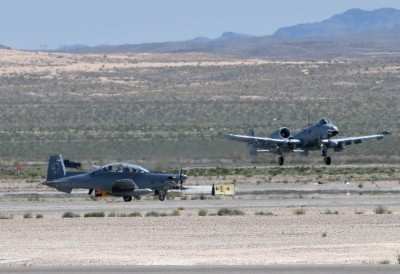Aircraft Filling Surveillance Role With Strike
Capabilities
Test pilots and engineers at Davis-Mothan AFB in Arizona are
learning what happens when high-tech systems are combined with
low-tech airframes for a new, cost effective, light-attack
aircraft. Light attack, a revitalized concept in the Air Force,
addresses the need for an airplane that offers surveillance as well
as strike capabilities and walks the line between remotely piloted
aircraft and high-performance fighters.

U.S. Air Force Photo
In appearance, Hawker Beechcraft AT-6Cs resemble the fighters of
yesteryear with single engine propellers and shark-face nose art.
They are, in actuality, one possible candidate for Air Force light
attack aircraft and the latest project for Air National Guard Air
Force Reserve Command Test Center officials based at Tucson
International Airport.
Lt. Col. Keith Colmer, a developmental test pilot and director
of engineering for AATC, deployed to Iraq in early 2008, where he
flew numerous close air support missions in F-16 Fighting Falcons.
During more than 100 combat hours, he served as an eye in the sky
for Army elements but he said he rarely engaged the enemy on their
behalf. "Right now we are paying a high cost to fly an F-16 in
terms of fuel and wear and tear for missions that don't require the
full capabilities of the airplane," said Colonel Colmer, who leads
AATC's light-attack program. "With fourth generation fighters
nearing the end of their service life, a light-attack platform
could take on these kinds of missions and lighten the load."
The test center, which conducts operational tests on behalf of
the Reserve, is manned by a team of active-duty, Guard, Reserve,
civilian and contractor members who field low-cost, low-risk,
off-the-shelf improvements for aircraft and weapons systems.
Officials said the center's unique efficiency is perfect for
building and evaluating a light-attack aircraft. "In keeping with
our '80 percent of the capability for 20 percent of the cost'
motto, we took existing technology from the A-10 (Thunderbolt II)
and F-16 and inserted it in the AT-6," Colonel Colmer said.

Hawker Beechcraft File Photo
Mounted next to the AT-6's manual flight controls, levers,
cables and pulleys are mission computers, situational awareness
data links, radios, helmet-mounted cueing systems, hands-on stick
and throttles, threat countermeasures and armament pylons typically
found on current fighter and attack aircraft. "We learned a lot
from initial testing earlier this year and made several
adjustments," Colonel Colmer said. "The testing this month is about
bringing in testers from around the Air Force; A-10 and F-16 pilots
from Edwards (Air Force Base, CA), Nellis (AFB, NV), and Eglin
(AFB, FL)"
"Overall, pilots are coming back after flying it excited about
light attack," Colonel Colmer said. "They're enjoying the sorties
and the aircraft's capabilities. Almost everyone has a list of
things they would like to change, but that's what we expected. Now
we'll take their input and make it a better aircraft."
Maj. Jesse Smith, an A-10 pilot from the 422nd Test and
Evaluation Squadron at Nellis AFB, flew the modified AT-6 during a
simulated combat search and rescue sortie October 7. "It's easy to
handle," Major Smith said. "They took some of the systems and
avionics from the A-10, so that made it easier for me to step in.
Based on the scenario we had today, we were able to go out and
execute. It's not the answer for everything, but if you look at
what's going on in Iraq and Afghanistan, it's a good concept that
can save money."
To buy and operate a light-attack aircraft costs pennies on the
dollar compared to an A-10 or F-16. For the A-10 or F-16, the cost
per flying hour is around 15,000 to 17,000 dollars for fuel and
maintenance. Test center officials say the AT-6 is currently
running at about 600 dollars per hour.
Though light attack is not viewed as a replacement for jets,
Airmen here are finding out that the two-seat turboprop can fill a
number of roles. Pilots are examining the AT-6 as a companion
trainer to give them a firsthand look at close air support from the
air. Combat controllers and tactical air control party members are
also evaluating the aircraft as a possible trainer. "Right now in
the (joint terminal attack control) community, there are not enough
sorties to keep them trained," Colonel Colmer said. "One thought is
that this type of aircraft could be based with their units so they
could get more practice with controlling an aircraft that
adequately replicates an A-10 or F-16. They could even fly more
often to gain a sense of a pilot's perspective."

AT-6, A-10 File Photo
In domestic operations it could support border security, counter
drug and homeland defense. For state missions, during fires, floods
or other disasters, it could use sensors to map out an area for
responders. Additionally, officials believe a light-attack platform
can help build partner nation air forces that lack the funding and
the need for jet-powered aircraft. "It's exciting to be a proponent
for light attack in this early stage when the possibilities seem
endless and we can demonstrate what one of these airplanes could
do," said Colonel Colmer, who emphasized that light attack is not
yet a procurement program.
Usually, testing occurs after an aircraft is purchased. In this
case, Colonel Colmer and his team have a unique opportunity to help
develop and refine a set of technologies and weapons for a
light-attack airplane and give decision makers a clear picture
before they buy a platform. "For the last 18 months, we've been
working on requirements and technologies to integrate on the
aircraft," Colonel Colmer said. "Future iterations of tests will
integrate Hellfire missiles, Aim 9 Sidewinders and various other
weapons."
 ANN's Daily Aero-Term (04.14.24): Maximum Authorized Altitude
ANN's Daily Aero-Term (04.14.24): Maximum Authorized Altitude ANN's Daily Aero-Linx (04.14.24)
ANN's Daily Aero-Linx (04.14.24) Classic Aero-TV: 'We're Surviving'-- Kyle Franklin Describes Airshow Life 2013
Classic Aero-TV: 'We're Surviving'-- Kyle Franklin Describes Airshow Life 2013 Aero-News: Quote of the Day (04.14.24)
Aero-News: Quote of the Day (04.14.24) Airborne 04.09.24: SnF24!, Piper-DeltaHawk!, Fisher Update, Junkers
Airborne 04.09.24: SnF24!, Piper-DeltaHawk!, Fisher Update, Junkers





